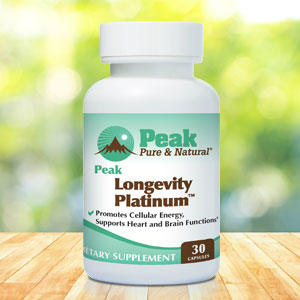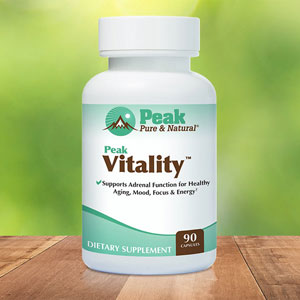Get Easy Health Digest™ in your inbox and don’t miss a thing when you subscribe today. Plus, get the free bonus report, Mother Nature’s Tips, Tricks and Remedies for Cholesterol, Blood Pressure & Blood Sugar as my way of saying welcome to the community!
10 micronutrients that turn the key on age reversal

Mitochondria are organelles that power cells by synthesizing adenosine triphosphate (ATP), the primary source of energy for most cellular processes.
That’s why their nickname is the “powerhouses of our cells.”
And as mighty power generators, mitochondria are associated with longevity — as long as they’re functioning optimally.
But when they aren’t, cellular energy production wanes, oxidative stress runs rampant, mitochondria become prone to DNA mutations, and the cellular processes that normally regulate programmed cell death and stress response become dysfunctional.
All this eventually leads to cellular decline and ultimately what we know as the aging process.
But if mitochondria eventually fail, why are they linked with longevity?
The key to age reversal
Aging may be inevitable, but that doesn’t mean there’s nothing we can do to slow it and enjoy more healthy years — especially now that we know mitochondria are the key.
In studies using C. elegans, a worm model often used in research, scientists saw that interventions could improve mitochondrial function — and extend lifespan.
In other words, our mitochondria could be revived — or motivated to keep churning out that good old ATP, and that’s made it a prime target for longevity research.
In fact, scientists believe mitochondria are behind the life-lengthening effects of calorie restriction, which has been proven to slow the pace of aging in humans.
Thankfully, eating less isn’t our only option to support mitochondria’s healthy aging effects…
Pyrroloquinoline quinone (PQQ) is a micronutrient found in some foods like natto, parsley and green tea, that helps mitochondria produce ATP. But it also increases the number of mitochondria, an important benefit since our bodies produce less as we age.
But longevity is just one part of aging research where mitochondria are breaking ground…
Mitochondria and skin aging
Experts have begun to explore the mitochondria’s role in cellular rejuvenation and the direct impacts that can have on the visible signs of aging.
“Mitoscientist” Dr. Keshav K. Singh is a world leader in mitochondrial health and disease and founder of the Mitochondria Research and Medicine Society in the US and India.
His research at the University of Alabama in Birmingham includes how mitochondria can slow, potentially even reverse, the signs of skin aging, opening promising avenues for therapeutic development.
Currently, that involves developing strategies to prevent, slow and treat skin wrinkles and hair loss in mice — and translating those benefits to humans.
Similar to the research I mentioned earlier using a worm model, Dr. Singh’s research involves a mouse whose age can be manipulated at will — actually made older and then, younger again — providing an unprecedented opportunity to understand tissue-specific aging.
It may be years before Dr. Singh’s research translates to products or procedures that change how our skin ages, but a prescription for healthy mitochondria may already exist…
10 micronutrients that support your mitochondria
Experts in aesthetic medicine in France are already working on a prescription for healthy mitochondria to support healthier aging.
Their answer is micro nutrition, consisting of PQQ and nine other ingredients, that protects mitochondria from oxidative damage and stimulates the growth of new mitochondria.
Their suggestions include:
Coenzyme Q10 (CoQ10), which helps mitochondria make ATP, the fuel that powers most cellular functions. CoQ10 is also a powerful antioxidant that helps control oxidative stress.
Nicotinamide adenine dinucleotide (NAD) is a form of vitamin B3 very popular in regenerative medicine. It’s an essential coenzyme in regulating metabolism, longevity, DNA repair and producing energy.
Erythrothioneine is an amino acid present in high quantities in mushrooms and is called a “longevity vitamin” by some. It guards mitochondria from free radical damage. It can also be applied to the skin to reduce signs of aging and sun damage.
Alpha-lipoic acid is an antioxidant that increases cellular levels of NAD. It may also enhance the anti-aging activity of sirtuins, genes that are involved in the regulation of metabolism and longevity.
The B vitamins, known as “respiratory’ vitamins (B1, B2, B3, B6 and B12) help balance magnesium in the body. Magnesium helps transport ATP.
Acetyl-L-Carnitine increases overall cellular respiration, and with D-ribose and N-acetylcysteine (NAC) optimizes respiratory chain activity — a process involved in generating power to synthesize ATP.
Lastly, omega-3 fatty acids, because they support the structure and function of mitochondrial membranes.
Editor’s note: Did you know that when you take your body from acid to alkaline you can boost your energy, lose weight, soothe digestion, avoid illness and achieve wellness? Click here to discover The Alkaline Secret to Ultimate Vitality and revive your life today!
Sources:
The Mitochondrial Basis of Aging — Journal Molecular Cell
The Mitodesign Lab — keshavsingh.org
Exploring the role of mitochondria transfer/transplant and their long-non-coding RNAs in regenerative therapies for skin aging — Mitochondrion
The mitochondria at the very heart of the anti-aging medicine — Anti-Age














